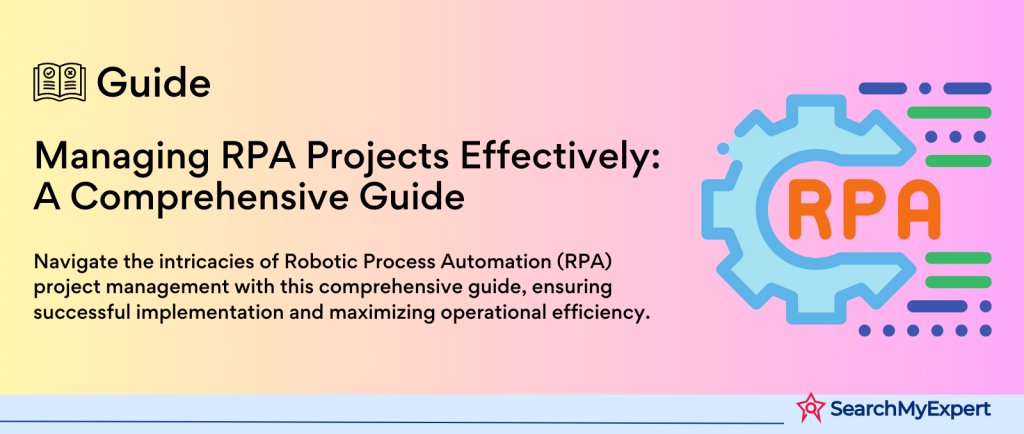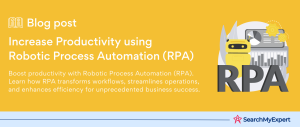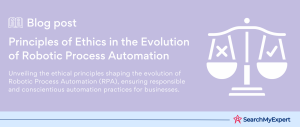Managing Robotic Process Automation Projects
Defining Robotic Process Automation (RPA)
Robotic Process Automation, or RPA, is a technological revolution in the business world. Imagine a software robot that can perform repetitive, rule-based digital tasks – that’s RPA for you. It’s like having an invisible digital workforce. RPA tools can mimic human actions like clicking, typing, and reading from the screen, making processes faster and error-free.
Benefits of RPA Projects
- Efficiency:
RPA significantly reduces the time taken to complete tasks. - Accuracy:
With RPA, human errors are minimized. - Cost-Effective:
It reduces operational costs by automating routine tasks. - Scalability: RPA systems are adaptable and can handle fluctuating workloads.
- Improved Employee Satisfaction: It frees up human workers from tedious tasks, allowing them to focus on more strategic activities.
Challenges in Managing RPA Projects
Managing RPA projects isn’t a cakewalk. It involves:
- Understanding Process Complexity:
Not all processes are suitable for automation. - Change Management: Introducing RPA requires a cultural shift within the organization.
- Technical Challenges: Integration with existing systems can be complex.
- Maintenance:
RPA tools need regular updates and maintenance. - Expectation Management: Balancing the hype around RPA with realistic expectations is crucial.
We’ll navigate through these intricacies, providing a comprehensive view of managing RPA projects effectively.
Project Definition and Feasibility Assessment
Identifying and Prioritizing RPA Use Cases
To kick off an RPA project, the first step is identifying and prioritizing use cases. Here’s how:
- Assess Routine Tasks: Look for repetitive, rule-based tasks across departments.
- High Volume Processes: Identify processes with high transaction volumes.
- Error-Prone Activities:
Focus on activities where automation can reduce errors. - Potential for Quick Wins:
Quick wins help in building momentum and showcasing value.
Conducting a Thorough Feasibility Study
A robust feasibility study is pivotal. It encompasses:
Process Selection and Mapping:
- Identify Suitable Processes: Not all processes are apt for automation.
- Process Mapping: Document each step of the process to understand the workflow.
Cost-Benefit Analysis:
- Estimate Costs: Consider the costs of software, implementation, and maintenance.
- Quantify Benefits:
Calculate time savings, efficiency gains, and error reduction.
Technical Feasibility Assessment:
- Integration with Existing Systems:
Assess how well RPA tools can integrate with current systems. - Technical Limitations:
Understand the limitations of RPA technologies.
Regulatory and Compliance Considerations:
- Compliance Needs:
Ensure the automated processes comply with legal and regulatory requirements. - Data Security:
Address how RPA will handle sensitive data.
By meticulously following these steps, you can set a solid foundation for your RPA project, ensuring it’s aligned with business goals and technically feasible.
Building the Project Team
Forming a Cross-Functional Team
Success in RPA projects hinges on assembling the right team. This team should be a blend of diverse skills and expertise:
Process Analysis and Redesign Experts:
- Responsible for identifying and reengineering processes suitable for automation.
RPA Technology and Development Specialists:
- Focus on the technical aspects, like selecting the right RPA tools and developing the automation scripts.
Change Management and Stakeholder Engagement Professionals:
- Key in managing the organizational change, ensuring smooth adoption, and engaging stakeholders effectively.
Defining Roles and Responsibilities
Each team member plays a crucial role:
- Project Manager:
Oversees the entire project, ensures adherence to timelines and budgets. - Business Analyst:
Bridges the gap between the business needs and technical solutions. - RPA Developer:
Codes and configures the RPA tools to automate the processes. - Quality Assurance Analyst:
Ensures the automated processes are error-free and efficient. - Change Manager:
Facilitates change, addresses resistance, and communicates with stakeholders. - IT Specialist: Ensures the RPA solution is compatible with existing IT infrastructure.
By clearly defining roles and responsibilities, each team member can contribute effectively, ensuring a cohesive and efficient approach to the RPA project.
Development and Implementation
Choosing the Appropriate RPA Platform and Tools
Selecting the right RPA platform involves:
- Compatibility with Existing Systems: Ensure the tool integrates seamlessly with your current IT infrastructure.
- Scalability: The chosen platform should be able to handle increased loads as your business grows.
- User-Friendliness: Consider the ease of use, especially for non-technical staff.
- Support and Community: Look for platforms with robust support and an active user community.
- Cost:
Analyze the total cost of ownership, including licensing, development, and maintenance.
Developing RPA Bots for Selected Processes
The development phase includes:
- Scripting the Bots: Using the chosen RPA tool to script the desired workflows.
- Customization:
Tailoring the bots to meet specific process requirements. - Collaboration: Involving IT and process experts to ensure alignment with business objectives.
Integrating the Bots into the Existing IT Infrastructure
Successful integration is crucial for functionality and includes:
- API Connections:
Establishing secure API connections with existing systems. - Data Flow Management:
Ensuring smooth data transfer between bots and other systems. - Compliance Checks:
Verifying that the integration complies with regulatory standards.
Testing and Refining the Bots
The final step is to:
- Conduct Thorough Testing: Run multiple tests to ensure the bots perform as intended.
- Error Handling: Implement robust error handling procedures.
- Performance Tuning: Refine the bots for optimum efficiency and accuracy.
- User Acceptance Testing:
Get feedback from end-users to make any necessary adjustments.
By following these steps, you ensure that the developed RPA bots are efficient, accurate, and seamlessly integrated into your business processes.
Change Management and User Adoption
Developing a Comprehensive Change Management Strategy
Effective change management is key to RPA success. Here’s what it entails:
- Stakeholder Engagement: Identify and engage key stakeholders early in the process.
- Communication Plan: Develop a clear communication strategy to convey the purpose and benefits of RPA.
- Addressing Concerns: Be proactive in addressing fears and resistance from employees.
Training and Supporting Users on New RPA-driven Processes
Training is critical for a smooth transition:
- Customized Training Programs:
Tailor training sessions based on users’ roles and interaction with RPA. - Hands-On Workshops:
Provide practical, hands-on training to build confidence. - Continuous Support:
Offer ongoing support and resources to help users adapt.
Communicating the Benefits of RPA and Addressing Potential Concerns
Clear communication can drive user adoption:
- Highlighting Efficiency Gains:
Emphasize how RPA can simplify tasks and increase productivity. - Transparency About Changes: Be honest about the changes RPA will bring, including role adjustments.
- Positive Reinforcement:
Share success stories and positive outcomes from RPA adoption.
Implementing these strategies will not only facilitate smoother adoption of RPA but also help in harnessing its full potential for organizational improvement.
Monitoring and Optimization
Establishing KPIs to Track RPA Success
Key Performance Indicators (KPIs) are vital for measuring the impact of RPA:
- Accuracy Rate: Measures the error rate of automated processes.
- Process Time Reduction:
Tracks the time saved due to automation. - Cost Savings:
Quantifies the financial impact of RPA implementation. - Employee Productivity:
Assesses the change in employee productivity post-automation. - Bot Utilization Rate: Evaluate how effectively the RPA bots are being utilized.
Monitoring Bot Performance and Identifying Areas for Improvement
Continuous monitoring is crucial for sustained success:
- Performance Dashboards: Implement dashboards for real-time monitoring of bot activities.
- Regular Audits:
Conduct periodic audits to assess bot performance and compliance. - Feedback Loops:
Create channels for receiving feedback from end-users and stakeholders.
Continuously Optimizing Processes and Bots
Optimization ensures RPA delivers ongoing value:
- Process Re-evaluation: Regularly review and update automated processes for efficiency.
- Bot Upgrades:
Keep the RPA bots updated with the latest features and improvements. - Scalability Assessments:
Ensure the RPA setup can scale with the business’s growth. - Best Practices Implementation:
Incorporate industry best practices for optimal performance.
By establishing robust monitoring and optimization mechanisms, you can ensure that your RPA initiative remains effective and continues to deliver value over time.
Future Outlook
Key Takeaways from the RPA Project
Reflecting on our journey through the implementation of Robotic Process Automation:
- Efficiency Boost:
RPA significantly improved our process efficiencies. - Error Reduction:
We witnessed a notable decrease in manual errors. - Cost Savings: The automation led to considerable cost reductions.
Lessons Learned and Potential Challenges
The journey wasn’t without its hurdles:
- Complex Integration: Integrating RPA with existing systems was challenging but crucial.
- Change Management:
Managing change effectively was key to user adoption. - Continuous Monitoring:
Ongoing optimization is essential for sustained benefits.
Future Outlook for RPA in Our Organization
Looking ahead, the role of RPA in our organization is set to expand:
- Scaling Up:
We plan to extend RPA to more complex, value-driven processes. - Advanced Technologies: Incorporating AI and machine learning for smarter automation.
- Strategic Integration: Aligning RPA with broader digital transformation goals.
Conclusion
Our RPA journey has been transformative, teaching us valuable lessons and opening doors to new possibilities. As we continue to evolve, RPA will remain a crucial element in our quest for operational excellence.
Collaborate with the best in automation technology – Robotic Process Automation Service Agencies.
Further Reading
- Robotic Process Automation and Digital Transformation
- Robotic Process Automation in Customer Service
- Advanced Analytics with Robotic Process Automation
- Robotic Process Automation Governance
- Enhancing Productivity with Robotic Process Automation
- The Role of Robotic Process Automation in IT Operations
Table of Contents
Toggle






